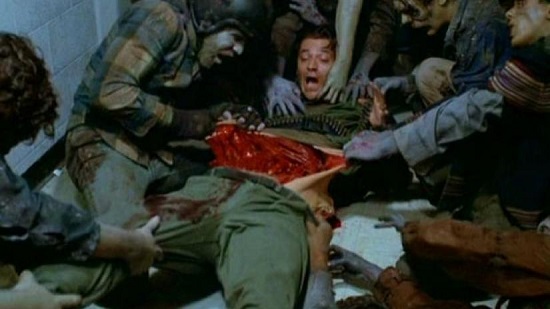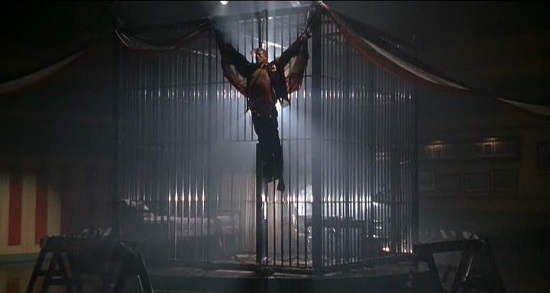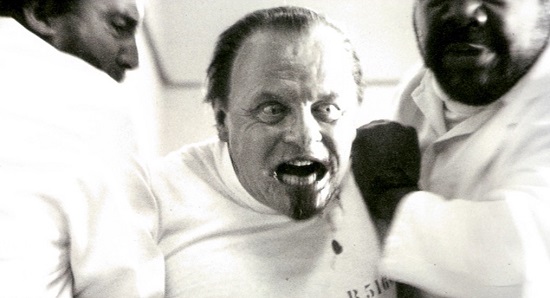“Don’t worry, Mom,” says Danny Torrance in The Shining. “I know everything about cannibalism. I saw a program on it on TV.”
It’s an early scene in the film. Danny and his parents are in their car, heading for the Overlook Hotel and talking about the Donner-Reed Party, a group of US pioneers who in 1846 became snowbound and resorted to eating those in their number who froze to death in order to survive. Cannibalism doesn’t feature again in the film – the plentifully stocked pantry negates the need for the Torrances to resort to such things – but on the topic itself Danny speaks for all of us. For the average Joe, cannibalism is something we come to know through the occasional news story, TV documentaries and, chiefly, cinema.
Although IRL occurrences are infrequent, the sheer gruesomeness of cannibalism makes it a handy, if rather hoary, shorthand for just about the worst thing that can happen to a person. So much so that, for those filmmakers setting out to serve up movies which appeal to audiences’ taste for being appalled and repulsed, human meat is a choice ingredient.
An early treatment of the topic is 1932’s Doctor X, a tale which features not only cannibal horror but also serial killer noir and mad professor sci-fi replete with a lab of bubbling chemical flasks. The film is an entertaining example of the kind of roaring grotesquery found in Hollywood prior to the introduction of the Motion Picture Production Code which came about two years later. It would be over three decades before cannibalism would again be a just-about-passable subject matter.
In the early 1960s Herschell Gordon Lewis, a director whose lack of skill was matched only by his abundance of enthusiasm, kickstarted a subgenre which would come to be known as the splatter movie. Lewis founded a career as one of independent cinema’s most notorious and influential figures with these cheap, hastily made productions which poured the majority of their barely existent budgets into creating scenes of brazen titillation, graphic violence and outrageous invention. Plot, script, performances, cinematography: these were all subsidiary. 1963’s Blood Feast, Lewis’s first stab at exploitation horror, centres around an Egyptian caterer in the thrall of an ancient goddess who demands he provide her with regular human meals, served up with a profusion of carnage hitherto nigh unseen in cinemas: skin is rent, limbs are hacked, tongues are yanked out and blood is generously sloshed across the set, all in garish Technicolor. Lewis had found his creative locus amid the rebellion and adventurousness of the 60s – Blood Feast was shot in less than a week, cost around $24,500 to make and went on to gross $7 million – but the film and its kin also pushed against that spirit, revelling in their own nihilism and sheer nastiness in a way which would become imperative for subsequent schlock auteurs: Blood Feast is a favourite of John Waters whose Pink Flamingos is another gross-out addition to the cannibal cannon.
1968 saw a new monster shuffle into the popular consciousness: the zombie. Although there had been a great many zombies in cinema before it, George Romero’s Night of Living Dead was the first time they had been portrayed as cannibals. The simplicity of the movie’s premise – a household under siege – makes it one which critics and theorists can project onto endlessly, but it’s the shuffling, decomposing automatons compelled by some unknown force to track and eat the living which have held the fascination of viewers across generations. Romero’s zombies – to this day still shambling around in the likes of The Walking Dead, The Girl With All The Gifts and Train To Busan – have embedded themselves firmly in the cinematic imagination because the anxiety they provoke is almost metaphysical: sure, you may feel there is more to you than your body but perhaps you are simply a sack of meat, admittedly galvanised for a time but as susceptible to the demeaning process of being ripped apart, wolfed down and excreted as any other animal. It’s not surprising that Romero’s two more successful sequels, Dawn Of The Dead and Day Of The Dead, would be respectively a satire on consumerism and a bleak weighing-up of humanity.

That same curiosity about what it means to be part of civilisation is something which also pops up in the cannibal boom, a brief spate of grim and schlocky movies which flourished in the late 70s. The titles like Primitives,Jungle Holocaust and Papaya, Love Goddess of The Cannibals give a good sense of this subgenre’s overall tone, not just in the salacious and lurid content the films trade in but also their problematic colonial politics.
Spearheaded by Italian director Umberto Lenzi who made the most successful (or least unsuccessful) entrants in the field, the plots of these films are often largely interchangeable: western protagonists – educated and intellectual yet brash and impetuous – encounter primitive cultures in remote provinces of Asia or South America, often with the intention of exploiting those they find and always with the end result of the natives exacting a nausea-inducing culinary revenge. A handful of the movies, such as Lenzi’s Cannibal Holocaust, at least gestured towards critiquing Western attitudes to exploitation (the plot revolves around a group of American filmmakers committing crimes which a tribe they’re documenting are blamed for, pushing the peaceable natives into becoming the cannibals they’ve been depicted as) and showed an interest in cinematic invention (Holocaust’s foray into a cinema verite style mockumentary foreshadows the likes of The Blair Witch Project and Paranormal Activity), but in truth both are negated by the xenophobia with which the ‘savages’ are routinely depicted. Nonetheless there is something about Holocaust which genuinely unsettles and that is the sense of a group of individuals being entirely at the mercy of a community whose empathy they cannot appeal to because they are seen by them not as people but as so much human beef.
The phobia of cannibalism which sees it as the endpoint of an insular, retrograde society is something of which science fiction and the post-apocalyptic are particularly enamoured. Films like Soylent Green, Delicatessen and Cloud Atlas all play on our anxieties about civilization by pitting their adversaries against people who, as a norm, eat other people. ‘We would never eat anybody, would we?’ asks the boy in 2009’s feted The Road. No, the man tells him, ‘because we’re the good guys.’ But 1989’s Parents had already blackly satirised this binary worldview with its young boy protagonist growing up in a classic 1950s suburb only to discover his all-American mom and pop are secretly blood-hungry ghouls addicted to human sausages.
But nowhere is the notion of workaday cannibalism being proof positive of a community gone horribly awry deployed so effectively as 1974’s The Texas Chain Saw Massacre. Although cut from the cloth of its era – a group of nubile teens take an off-road trip only to get acrobatically eviscerated by a family of gibbering lunatics – The Texas Chain Saw Massacre remains totemic by dint of how genuinely unhinged it seems. The film’s combination of nuanced antagonists, blasé violence and a grubby attention to production design makes for disquieting viewing to this day, not least in the personage of Leatherface, the backward, almost childlike butcher who not only slaughters, hews and eats the family’s victims but – truly a renaissance man – also stitches together their faces into a patchwork mask, decorates the homestead with wind-chimes and dreamcatchers made from their bones and upholsters its banquets and chaises longues with their flayed skin. Although gruesome scenes abound, the film’s most disturbing moment takes place during a dinner party where Leatherface et famile attempt to crack open the head of Marilyn Burns, the sole remaining member of the Scooby gang for a festive treat. Trussed up in a chair at the head of the table, her wailing, pleading and swivel-eyed terror elicit only jolly giggles of bonhomie from her captors, nudging cannibalism beyond the usual motives found in most cinematic depictions – superstitious beliefs (Ravenous), deviant sensuality (Trouble Every Day), quasi-scientific supernatural malevolence (pretty much all zombie films) – and into a senseless, screaming insanity which is far more believable and far more scary. No genuine reason for the family’s cannibalism is proffered beyond them simply enjoying it. There is something especially awful about a person, with all their youth, hopes and quirks, being quite literally reduced to fuel for madmen.
Our response is different when it comes to the unwitting cannibal. The common dramatic trope of human meat being served up to the unsuspecting is perhaps the only thing which links Titus Andronicus and The Rocky Horror Picture Show. But the most striking instance takes place in Fried Green Tomatoes, a film otherwise largely remembered a gentle piece of 90s mumcore wistfulness. Fried Green Tomatoes climaxes with one of the movie’s female protagonists murdering her abusive husband, dismembering his body and disposing of the remains by cooking them and serving them up to entirely oblivious customers, including the police officer investigating the husband’s disappearance and who has an unfortunate weakness for ribs. Cannibalism here is not the fruit of mindless savagery but something almost the opposite, a piquant taste for revenge, considered in its execution and gleeful in the squalor it knowingly accords the victim, and somehow all the more apt given the gender politics at play. Cannibalism as vengeance is something which similarly plays out in Sweeney Todd, The Neon Demon and, most memorably, The Cook, The Thief, His Wife & Her Lover, Peter Greensway’s stylised tale of a venal gangster entering the sophisticated world of high society. Michael Gambon’s titular thief, a blustering career chauvinist, is eventually punished by being forced by his wife into an act of cannibalism, an indelible degradation even for a murderous thug.
With cannibalism being such a potent nightmare for the viewing public, it’s perhaps not surprising that the most successful horror movie, if Oscars are anything to go by, features cinema’s best-known cannibal. Silence Of The Lambs made Hannibal Lecter, the intellectual cannibal, the cinema monster of the 1990s. Despite this aside from a fleeting shot of him biting into the nose of one of his guards during an escape, we never actually see Lecter eating anyone. In fact Lecter famously spent only 15 minutes of the two hour running time onscreen for his Best Actor win. Lecter’s success as a character is down in no small part to his being a cerebral cannibal, embodying not, as in The Texas Chain Saw Massacre, our fears of encountering those who lack civilisation but of encountering those who have too much. It is Clarice Starling who, as Lecter phrases it is ‘one generation from poor white trash’, who is the film’s hero. By contrast Lecter is an educated aesthete, refined to the point where he has cultivated a sybarite appreciation for flesh much like he has for opera and architecture.

What gives Lecter his potency in Silence Of The Lambs isn’t anything he does. Rather it’s what surrounds him: a mixture of the fear he provokes in the other characters, the anecdotes relayed about him, the heightened security protocols of his prison and Hopkins’ own performance, camp as anything and hammier than David Cameron’s Tinder profile, yet somehow all the more sinister for it. Things falter in the sequels Hannibal and Red Dragon where we see Lecter at play in the world, just another humdrum psychopath. Simply put, Lecter as myth frightens, Lecter as man, not so much.
Which is fitting. Cannibals have always been much more a figment of our collective imaginations than a reality, channelling our intimate and unnameable fears – others, ourselves, our bodies, death and what follows death. In reality, Alive, the dramatisation of those who survived a plane crash in the Andes in 1972 by consuming their less fortunate fellow passengers, is probably the depiction of cannibalism which has the closest relationship with reality.
And yet… perhaps the madness which those of Air Force Flight 571, and the Donner-Reed party trapped not far from the location of the Outlook Hotel, must have summoned in order to survive still lurks unseen in our landscape, waiting for its chance to feast.
A 4K transfer of Silence Of The Lambs opens in selected cinemas today


